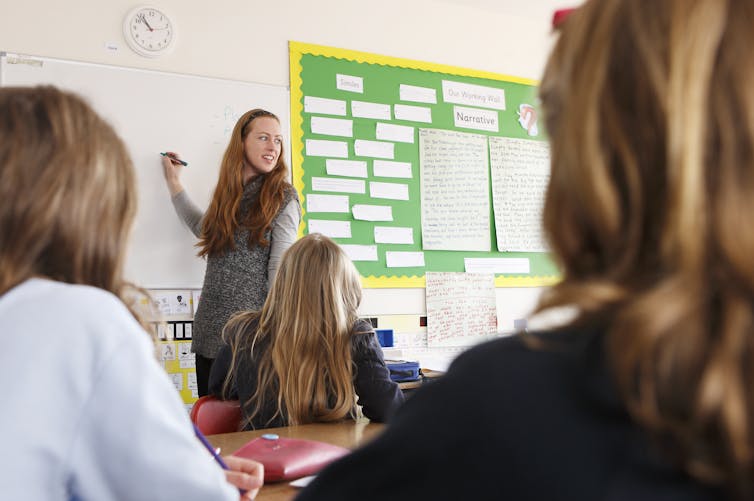Anyone watching the debate over the National Party’s recent curriculum policy announcement could be forgiven for thinking there is a deep divide in education philosophy and best practice in New Zealand. The truth isn’t quite that simple.
In fact, most (if not all) interested parties would agree that teaching and learning the basics of literacy and numeracy are vital. As one expert observer noted, the policies of the major political parties actually have much in common.
The National Party policy promises a curriculum focused on “teaching the basics brilliantly”. The government says much of this work is already under way with its current curriculum “refresh”. So where exactly is the issue?
The idea of mandated testing checkpoints clearly has some worried that the National Party’s policy is a return to a “back to basics” mentality that ignores or minimises other vital areas of teaching. As one headline had it, “KPIs are for businesses and boardrooms, not children and schools”.
While the basics are important, the argument goes, there are other things schools should focus on. That may be true, but it need not be so binary. Basic early literacy and numeracy skills are the foundation on which much other success is built.
Perhaps a better way to frame the discussion might be: a wider view of learning is important – and the basics are necessary.

Getty Images
Learning to read and write is hard
Foundations take time to put in place, however. With reading and writing, for example, it’s common for capable adults to assume that many of the foundational skills are easily achieved.
In fact, neuroscience shows literacy learning is a remarkably complex process. Learning to identify letters and the sounds associated with them, and learning to read and retain words, involves a kind of repurposing of the brain’s architecture.
Learning to correctly spell words is even more complex than reading them. Successful teaching of spelling requires clear and systematic guidelines. Mastery cannot be left to chance or done through rote learning lists of words.
Has a gap in old-school handwriting and spelling tuition contributed to NZ’s declining literacy scores?
Another often undervalued basic skill is handwriting. It can be seen as purely a presentation technique and simply about neatness. But research shows handwriting skill contributes directly to writing achievement and is the best predictor of writing success in younger students.
Reading and writing also rely on a foundation of oral language skill, including understanding sentence structure and having a strong vocabulary. Being proficient with sentences is the building block for paragraph formation, essential to more advanced writing tasks. Vocabulary knowledge is a strong predictor of academic achievement, connected to both reading and writing success.

Getty Images
What teachers want
None of these skills develop by chance. So the question becomes, how can a curriculum best support teachers to teach literacy from its foundations upwards, with as many students as possible succeeding?
In my work as a literacy facilitator, I find teachers want specifics. They want to know what to teach at each stage. They want to know what the children in their classes should be able to do within that year. They want to know what denotes progress, and when they should be concerned.
Teachers need a lot of things right now, but another curriculum ‘rewrite’ isn’t one of them
But the curriculum as a whole is necessarily broad and all-encompassing, to reflect the complex needs of society. The curriculum refresh groups learning in broad bands – and this presents problems for specific guidance and benchmarks.
In the English curriculum, one of the literacy goals for learners in the year 1-3 band is to “use decoding strategies with texts to make meaning”. This is far too broad to be helpful in teaching or assessment in any specific way.
More nuanced progress indicators are still being developed, but the draft examples suggest there will be more guidance in more specific age bands.
Education expert John Hattie’s new book draws on more than 130,000 studies to find out what helps students learn
Guidelines and benchmarks
As well as through the curriculum, teaching will be supported by the Literacy & Communication and Maths Strategy and the Common Practice Model. As an educator, I hope the final versions of these documents will offer clear guidelines for both teaching and assessment.
And there are new resources recently provided to schools that contribute usefully to a systematic and successful approach to literacy teaching. These are based on current evidence of how reading is best taught. They include a progression of word learning framework, and decodable readers with lesson plans.
All of these resources should provide useful direction for schools in their literacy teaching. While we can never make the task of teaching literacy simple, specific guidelines can make the pathway for teaching more straightforward.
More focus on the basics need not be boring for learners, either. I recently observed a lesson where the children were learning to decode new words. At the end, a six-year-old said “that was fun, can we do more?” The act of laying foundations for literacy is anything but dull.
The National Party’s call for guidelines around “teaching the basics brilliantly” speaks to a vital part of a rounded education. More detail is now needed about what “brilliance” will mean in practice, just as we need more detail on the current curriculum refresh. Making foundation skills a key component of the curriculum may not be the whole answer, but it is absolutely necessary for overall success.




